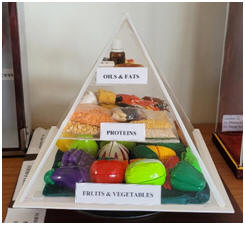
Department : Public Health Dentistry


|
Grains form the lowest level and the foundation of the pyramid. | |
|
Grains contain complex carbohydrates, B vitamins, iron, protein, magnesium and fiber. | |
|
6 to 11 servings each day (at least 50% of your total calories) from this group, which includes cereals, rice and pasta. | |
|
Fruits and vegetables are the next level. | |
|
These foods are naturally fat- and cholesterol-free, as well as low in sodium. | |
|
They also contain a rich supply of vitamins A and C, potassium, magnesium and fiber, which may reduce the risk of certain cancers. | |
|
Dairy, meat and meat alternatives are on the pyramid’s third level. | |
|
Dairy products – such as cheese and milk – provide calcium, protein, vitamins B, D and A. | |
|
The meat and meat alternatives – which include poultry, fish, dry beans, eggs and nuts – are rich sources of protein, phosphorus, Vitamins B, zinc, magnesium, iron, niacin and thiamin. | |
|
2 to 3 servings from each of these groups daily. | |
|
The top of the pyramid is for fats, oils and sweets. | |
|
These foods are all high in calories, but low in nutritional value. | |
|
Foods with high fat content include margarine, butter, salad dressing, mayonnaise, cream, cream cheese and sauces. | |
|
Everything from cake, pie and doughnuts to soft drinks falls in the “sweets” category. | |
|
Eat very sparingly from this group. |
